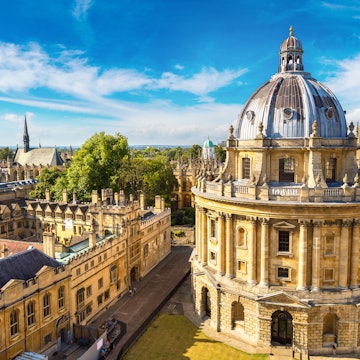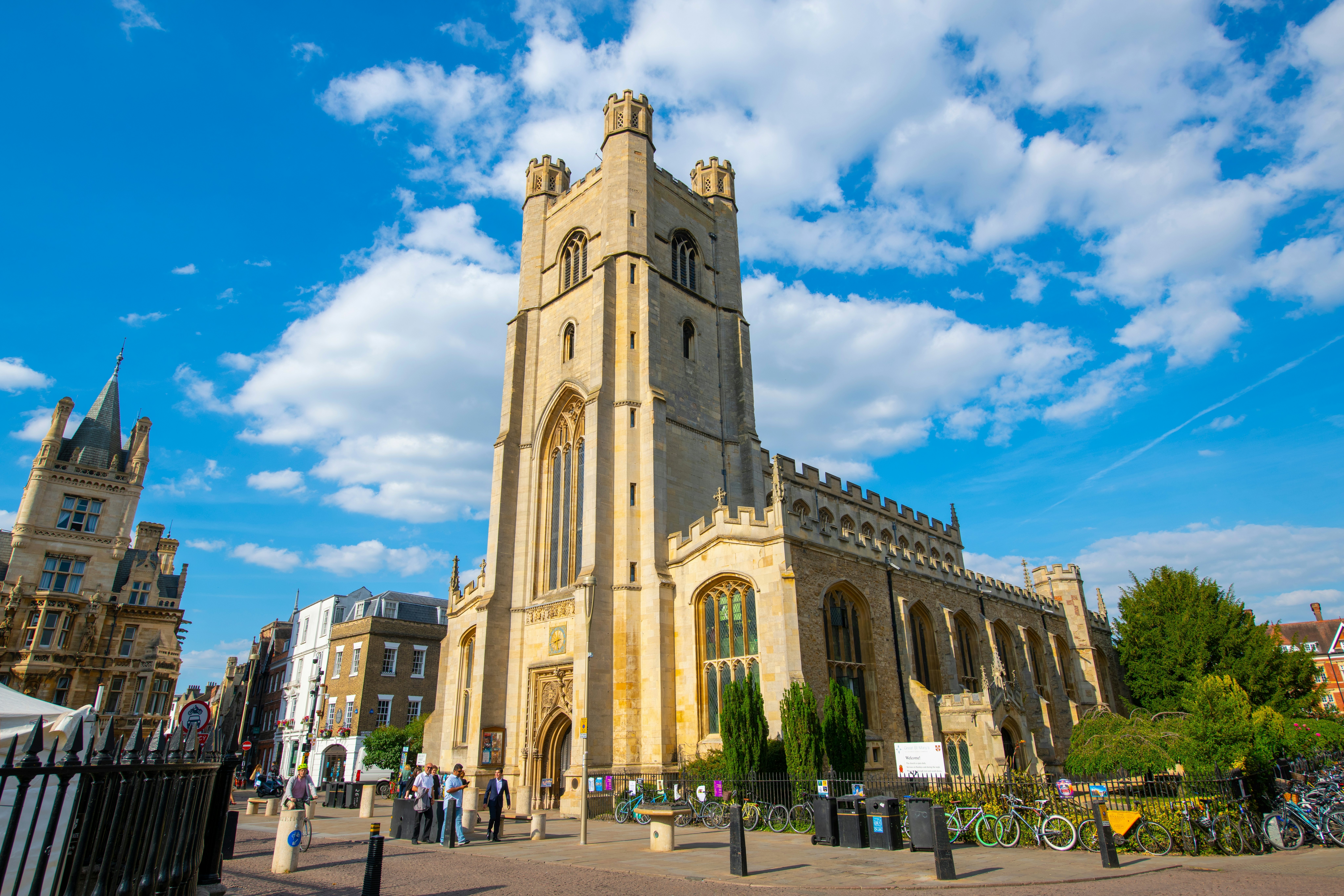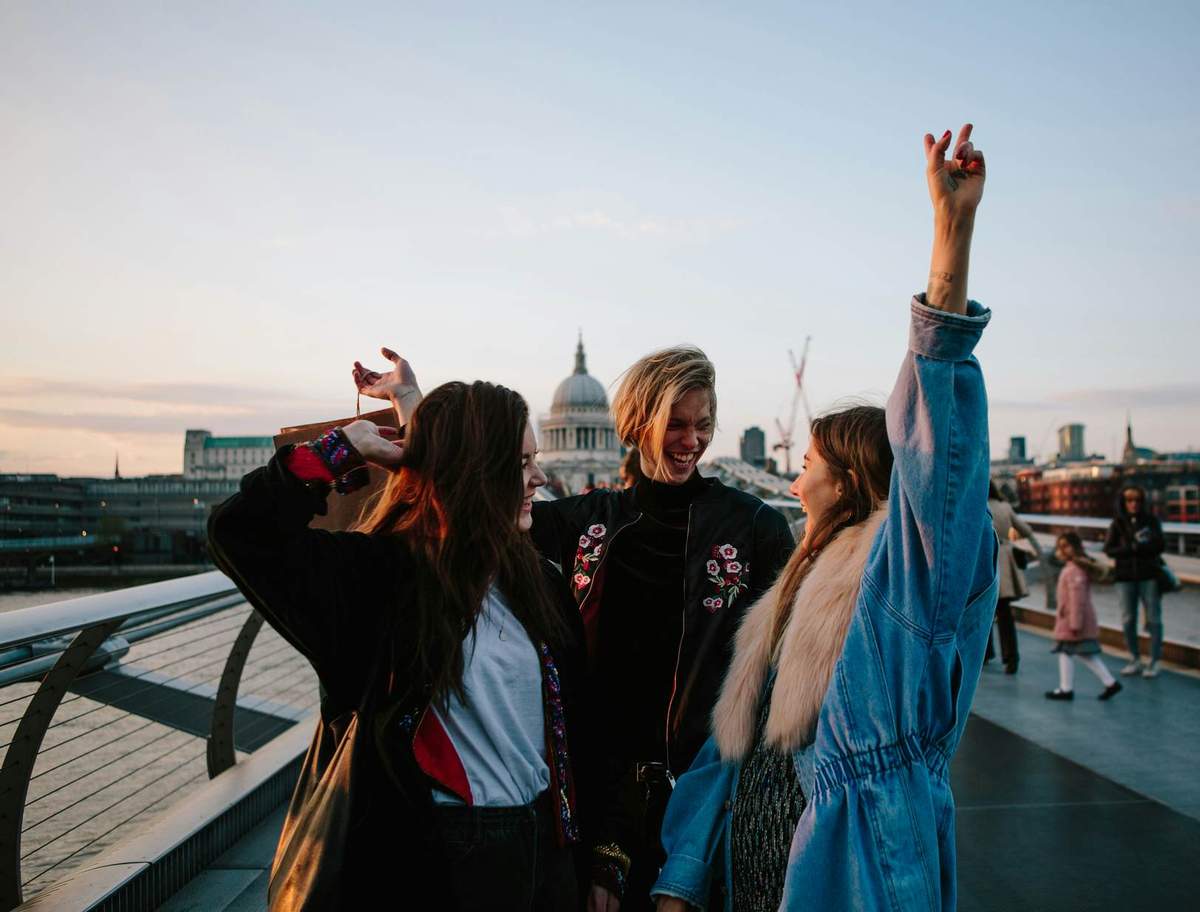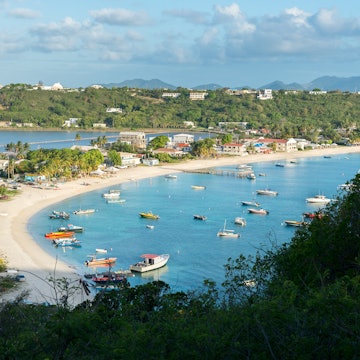

From exploring historic colleges to punting on the River Cam, there's plenty to keep you busy in Cambridge. Cristian M Balate/Shutterstock
If the east of England has one superstar city, it’s Cambridge. This appealing jumble of historic streets and cultured colleges is the archetypal English country town, home to one of Europe’s oldest and most prestigious universities.
At first glimpse, Cambridge can seem a little antiquated, with its Hogwarts-style colleges, pedaling academics and gliding punts. But the city has an edge too, best experienced in its agreeable pubs and hip restaurants as well as on stage, particularly during the annual Cambridge Footlights comedy revue.
With Cambridge being a lodestone for knowledge, there are some fascinating museums attached to the university, covering everything from archaeology to polar exploration. And while the colleges exude a definite air of wealth and privilege, there’s much to see for free, from historic churches to the world-class Fitzwilliam Museum.
Here are the best things to do in Cambridge to help you plan an itinerary for this charming and historic university town.

1. Soak up the architecture and atmosphere of Cambridge’s iconic colleges
Every one of the historic colleges that make up the University of Cambridge is an architectural wonder, but the grandiose 16th-century chapel at King’s College is a vision of heaven on earth. To get the measure of this extraordinary Gothic monument, come during a service to hear the sound of the chapel’s famous choir and organ reverberating off the walls beneath the world’s largest fan-vaulted ceiling.
Other top-tier colleges that warrant a visit are elegant St John’s, with its famous Gothic bridge and Tudor gatehouse, Christ’s College, with its gilded heraldic gate and elegant courts and gardens, and Gonville & Caius, marked out by the grand baroque Senate House and its three ceremonial gates, known as Virtue, Humility and Honor.
To delve deeper, visit photogenic, Hampton Court-like Queens’ College, Georgian-fronted Peterhouse, Emmanuel with its chequerboard-floored chapel, and Trinity College, most famous for being the alma mater of the great astrophysicist Stephen Hawking. Also drop by Pembroke to see Wren’s first chapel, and Magdalene, home to a library bequeathed by the diarist Samuel Pepys.
Planning tip: Members of the public are welcome to attend Evensong at any college chapel; it’s worth visiting these gorgeous religious spaces by day, too, to soak up the air of history and ceremony that surrounds them.

2. Go punting on the River Cam
Navigating the river that runs through town (known variously as the Cam and Granta) on a pole-propelled punt is the most Cambridge-y experience imaginable. At the Bridge St and Silver St bridges, you can join punt tours led by current and former students, or rent a self-poled punt to explore. Guides certainly cram their tours with facts, but the central section of the river can feel as crowded as Venice’s Grand Canal in peak season.
Scudamore’s and Cambridge Chauffeur Punts are reliable punt operators, with efficient depots in the center getting visitors out onto the river with minimum fuss. For faster navigation, you can also rent canoes and kayaks – Scudamore’s has a wide selection of vessels.
Detour: For a more rural experience, punt for an hour past meadows and English gardens to Granchester, with its thatched cottages, flower-filled gardens and classic cream teas. Stop for a snack at the genteel Orchard Tea Garden, once a favorite haunt of Virginia Woolf and the Bloomsbury Group, before heading back to Cambridge.
3. Track down the Corpus Clock's hideous time-eating insect
Outside graceful Corpus Christi College on King’s Parade, you can set your watch – or at least try to – at the 24-carat gold Corpus Clock. First unveiled in 2008, this fantastical timepiece is operated by a hideous clockwork insect “time-eater” that turns the cogs with its legs.
Unlike most other clocks, this whimsical timepiece is only accurate once every five minutes. At other times, it slows down, stops or speeds up – a tribute, according to its creator JC Taylor, to life’s irregularity.

4. Absorb history at the Fitzwilliam Museum
Fondly dubbed “The Fitz” by locals, the colossal neoclassical treasure house known as the Fitzwilliam Museum is actually just the grandest of the University of Cambridge’s many student museums. Imagine being a student and being able to browse not only the best libraries in the country, but also one of Britain’s finest collections of artworks and classical treasures!
As you wander the galleries, you’ll spot plenty of students studying up on Mediterranean history by examining the museum’s exquisite classical ceramics, old master paintings, and Roman, Egyptian and Cypriot grave goods, part of a collection bequeathed by the 7th Viscount Fitzwilliam to his old university.
Detour: After swotting up on ancient culture, grab yourself a treat at Fitzbillies, a Cambridge institution that serves the city’s stickiest, sweetest Chelsea buns. The closest branch is just north of the museum along Trumpington St, close to Pembroke College.
5. Admire the curated collection at Kettle’s Yard
If you’ve ever wondered what art gallery curators do at home, pop into Kettle’s Yard, a living art gallery created by HS “Jim” Ede, former curator at the Tate Gallery in London. Free guided tours explore a lifetime’s collection of artworks and found objects, displayed in a row of imaginatively converted cottages.
Look out for works by Joan Miró, Henry Moore and lesser-known artists such as primitive nautical painter Alfred Wallis. Don’t be tempted to move anything – it’s a condition of the museum’s bequeathment that everything is preserved exactly as Ede left it!

6. Find serenity in Cambridge’s lush botanic gardens
The Cambridge University Botanic Garden was created as a teaching tool for students in 1846, before being thrown open to the general public. Founded by Charles Darwin’s mentor, Professor John Henslow, this green expanse is full of hidden corners and secret spaces, making it a great place for a game of hide-and-seek with the kids.
If you’re more botanically minded, there are over 8000 plant species to admire, from mature deciduous trees to an army of pitcher plants and palms in the Victorian-era greenhouses.
Planning tip: It's a joy to wander the gardens and greenhouses independently, but informative free guided tours run twice daily on Sundays throughout the year.
7. Delve into history, science and more at the university museums
After touring the Fitzwilliam, you can get off the tourist trail at the University of Cambridge’s other charming student museums. Start south of the center at the Polar Museum, stuffed with explorers’ expedition gear, photographs, maps, journals and tragic last messages.
At the university’s Downing St campus, the Sedgwick Museum of Earth Sciences contains a stellar collection of fossils, including specimens collected during Charles Darwin’s groundbreaking voyages. Close by, the Museum of Archaeology & Anthropology displays cultural objects from as far away as the South Pacific and British Columbia, Canada.
A short walk west, the excellent Museum of Zoology has myriad bones and beaks, plus a two-horned narwhal suspended from the ceiling. Around the corner is the Whipple Museum of the History of Science, with an intriguing collection of telescopes, astrolabes and sextants.

8. Take yourself to church
Cambridge’s ancient churches are jammed full of history. Start the ecclesiastical journey at Great St Mary’s, close to King’s College, where a modest fee gains you access to the top of the tower and epic views over a sea of dreaming college spires.
Further south near Peterhouse College is dainty Little St Mary’s, containing a memorial to student Godfrey Washington, great-uncle of George, whose family coat of arms was reputedly the inspiration for the American flag.
North of Great St Mary’s is the curious Round Church, an arcane-looking chapel originally constructed in 1130 by the Knights Templar, remodeled from a Gothic design after the tower collapsed in 1841.
Planning tip: Excellent guided tours have been leaving from the Round Church for 25 years, exploring the Cambridge colleges and sites linked to the English Reformation and the writer CS Lewis. Most popular are the university tours starting every Wednesday, Thursday, Friday, and Saturday at 2:15pm. Alternatively, informative city tours led by blue-badge or green-badge guides can be arranged through the Society of Cambridge Tourist Guides.
9. Gain some college knowledge
For a brainiac tourist experience, public lectures on wide-ranging and often highly intellectual topics are held at Cambridge colleges throughout the year – just check the official schedule for upcoming talks. Another rewarding stop is the legendary Cambridge University Press bookstore on Trinity St, the oldest bookseller in Britain, founded in 1534. Here, you’ll find the latest publications on everything from climate change to quantum mechanics.
Detour: For more bookworming, join a tour to view the legendary Parker Library at Corpus Christi College, which holds the world’s finest collection of Anglo-Saxon manuscripts. Also take time to visit the Wren Library at Trinity College, which has been open to bibliophiles since 1695.

10. Explore the green and serene college Backs
To get a better understanding of life at the Cambridge colleges, pop behind the college’s street-facing facades to The Backs – a peaceful sprawl of formal gardens, neatly trimmed lawns and meadows that are still occasionally grazed by livestock, set within the college grounds.
Whether you’re exploring on foot or by punt, the bridges linking the college's precincts on both sides of the river are the focus of attention. Most famous is the fanciful Rialto-style Bridge of Sighs in the grounds of St John’s College. Nearby is the more restrained Kitchen Bridge, built following designs by Christopher Wren in 1709.
The oldest river crossing is the Clare College Bridge from 1639; note the decorative balls, one allegedly vandalized by the architect in protest at his disappointing fee. Further south is Queens’ College’s wooden Mathematical Bridge – despite what some guides say, it was not designed by Isaac Newton or assembled without nuts and bolts, but it’s still a striking geometric construction.
Detour: When hunger calls, go where the students go and grab a bite at Aromi, a local institution serving stacked Sicilian-style pizza slices and good gelato, or The Locker Cafe, a sociable student cafe offering trendy toast toppings and light lunches.
11. Get in on the action at Cambridge’s best events
As a bustling university town, there’s always something interesting going on in Cambridge. Come March and June, the river is taken over by college rowers for the energetic Bumps – rowing races held at Lent and in May on the Granta river, when college crews try to “bump” their rivals’ boats. In April and May, the Footlights Revue at the Cambridge Arts Theater celebrates top comedy from the Footlights student comedy troupe, which launched almost every British comic you know.
In May, you’ll see lots of high-spirited beer drinking on Jesus Green during the Cambridge Beer Festival. And in July and August, you won’t want to miss the Cambridge Shakespeare Festival, held in the evocative settings of the college courts.

12. Grab a pint at The Eagle
For the complete college experience, sink a pint at The Eagle, just round the corner from King’s College Chapel. This historic, wood-lined pub, founded in 1667, has poured pints for war heroes and legendary scientists.
In 1953, the pub cemented its place in history when Watson and Crick chose their favorite watering hole to announce that they had discovered the structure of DNA. Along with Rosalind Franklin, Maurice Wilkins and others at the University of Cambridge’s Cavendish Laboratory, they are honored with a plaque inside the pub.
During WWII, the pub became a hangout for American and British air aces, some of whom left their mark in the form of graffiti on the pub ceiling. Today, locals and visitors gather to relax with a pint in the beer garden or fill up with a classic Sunday roast.
Detour: There are plenty more characterful pubs in Cambridge where you can join local students for a pint. Reliable favorites include the agreeably independent Maypole and craft beer-oriented Cambridge Brew House.
13. Shop the stalls in Market Square
Located near Great St Mary’s Church and the Guildhall, Cambridge Market Square has been a hub for community and commerce for centuries, and it’s still the city’s main marketplace. Visit to browse a rotating collection of stalls selling fresh produce and flowers, baked treats, artisan foods, crafts, vintage clothing and books.
Vendors in the attached food market hawk an array of classic British and international dishes. The market is open daily, except for Christmas Day, Boxing Day and New Year’s Day, and it gets busy at lunchtimes, particularly at weekends.
Detour: Just a few blocks away, All Saints Garden on Trinity St hosts an arts and crafts market on Saturdays where you can shop for unique gifts and artworks.
This article was adapted from Lonely Planet’s Great Britain guidebook, published in July 2023.















